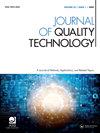利用个人清晰的效果进行智能因素分配和设计选择
IF 2.2
2区 工程技术
Q2 ENGINEERING, INDUSTRIAL
引用次数: 0
摘要
广泛的研究已经进行了如何选择有效的设计相对于一个标准。大多数设计标准的目标是捕获所有列的整体设计效率。当先前的信息表明少数因素及其双因素相互作用(2fi’s)可能比其他影响更重要时,常用的最小像差设计可能不再是最佳选择。受现实生活实验的启发,我们提出了一类新的规则分数阶乘设计,其重点是估计列的子集及其相应的2fi的其他重要影响。在引入个体清晰效应(iCE)的概念来描述涉及特定因素的清晰2fi之后,我们定义了清晰效应模式准则来表征iCE在所有列上的分布。然后,我们获得了一类新的设计,这些设计依次最大化了清晰的效果图案。这些新建的设计往往不同于现有的最优设计。我们开发了一系列理论结果,这些结果对于构建具有大型运行规模的设计特别有用,因为算法构建在计算上具有挑战性。我们还提供了一些实用指南,说明如何根据不同的运行尺寸、因素数量和需要明确的2fi数量选择合适的设计。本文章由计算机程序翻译,如有差异,请以英文原文为准。
Utilizing individual clear effects for intelligent factor allocations and design selections
Abstract Extensive studies have been conducted on how to select efficient designs with respect to a criterion. Most design criteria aim to capture the overall efficiency of the design across all columns. When prior information indicated that a small number of factors and their two-factor interactions (2fi’s) are likely to be more significant than other effects, commonly used minimum aberration designs may no longer be the best choice. Motivated by a real-life experiment, we propose a new class of regular fractional factorial designs that focus on estimating a subset of columns and their corresponding 2fi’s clear of other important effects. After introducing the concept of individual clear effects (iCE) to describe clear 2fi’s involving a specific factor, we define the clear effect pattern criterion to characterize the distribution of iCE’s over all columns. We then obtain a new class of designs that sequentially maximize the clear effect pattern. These newly constructed designs are often different from existing optimal designs. We develop a series of theoretical results that can be particularly useful for constructing designs with large run sizes, for which algorithmic construction becomes computationally challenging. We also provide some practical guidelines on how to choose appropriate designs with respect to different run size, the number of factors, and the number of 2fi’s that need to be clear.
求助全文
通过发布文献求助,成功后即可免费获取论文全文。
去求助
来源期刊

Journal of Quality Technology
管理科学-工程:工业
CiteScore
5.20
自引率
4.00%
发文量
23
审稿时长
>12 weeks
期刊介绍:
The objective of Journal of Quality Technology is to contribute to the technical advancement of the field of quality technology by publishing papers that emphasize the practical applicability of new techniques, instructive examples of the operation of existing techniques and results of historical researches. Expository, review, and tutorial papers are also acceptable if they are written in a style suitable for practicing engineers.
Sample our Mathematics & Statistics journals, sign in here to start your FREE access for 14 days
 求助内容:
求助内容: 应助结果提醒方式:
应助结果提醒方式:


